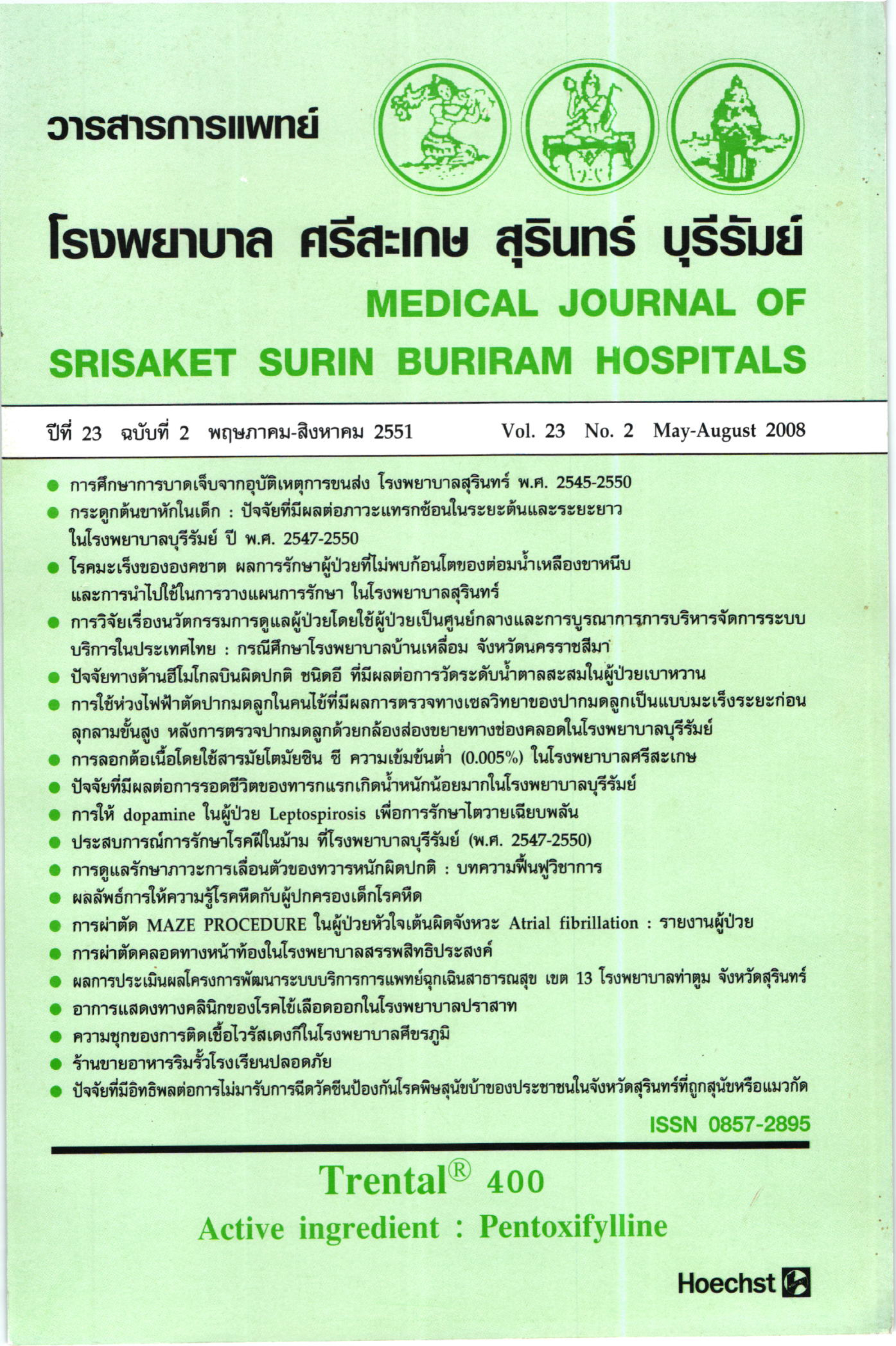ปัจจัยที่มืผลต่อการรอดชืวิตของทารกแรกเกิดน้ำหนักน้อยมากในโรงพยาบาลบุรีรมย์
Main Article Content
บทคัดย่อ
หลักการและเหตุผล: จากการจัดตั้งหน่วยทารกแรกเกิด (newbornunit) ของกลุ่มงานกุมารเวชกรรม โรงพยาบาลบุรีรัมย์ เมื่อปี พ.ศ. 2528 ได้พัฒนาและเปลี่ยนชื่อเป็นหน่วยงาน ทารกแรกเกิดป่วยหนัก (NICU = Newborn Intensive care unit) ในปี พ.ศ. 2536 มีทารกแรกเกิดที่น้ำหนักน้อยกว่า 2,500 กรัม เป็นจำนวนมากที่เข้ามา รับการรักษา และพบว่าทารกแรกเกิดน้ำหนักตัวน้อยกว่า 1,500 กรัม มีจำนวนการรอดชีวิตมากขึ้น
วัตถุประสงค์: เพี่อศึกษาปัจจัยที่มีผลและอัตราการรอดชีวิตของทารกแรกเกิดน้ำหนักน้อยมาก ในโรงพยาบาลบุรีรัมย์
วิธีการและสถิติ: เป็นการศึกษาแบบย้อนหลัง (Retrospective) จากการเก็บข้อมูลของเวชระเบียน ทารกแรกเกิดที่น้ำหนักน้อยกว่า 1,500 กรัม ทีเข้ารับการรักษาในโรงพยาบาล บุรีรัมย์ ระหว่างวันที่ 1 มกราคม พ.ศ. 2547 ถึง 31 ธันวาคม พ.ศ. 2549 เป็น ระยะเวลา 3 ปี
ผลการศึกษา: จำนวนทารกที่ศึกษา 146 ราย มีอัตราการรอดชีวิตร้อยละ 76.71 (114/146)ทารกที่น้ำหนัก 1,000-1,499 กรัม มีอัตราการรอดชีวิตร้อยละ 94.6 และอายุครรภ์ มากกว่า 30 สัปดาห์ขึ้นไป มีอัตราการรอดชีวิต ร้อยละ 82.1 ปัจจัยที่มีผลต่อ การรอดชีวิต คือ การให้ early enteral feeding ร้อยละ 87.5 การให้สารน้ำ ไม่เกินร้อยละ 80 ตามความต้องการของร่างกายใน 72 ชั่วโมงหลังคลอด ร้อยละ 75.9 และการไม่มีภาวะติดเชื้อในกระแสเลือด ร้อยละ 76.8 เป็นปัจจัยที่มีผลต่อ การรอดชีวิตของทารกแรกเกิดน้ำหนักตัวน้อยมาก
สรุป: ปัจจัยที่มีผลต่ออัตราการรอดชีวิตของทารกแรกเกิดน้ำหนักน้อยมากในโรงพยาบาลบุรีรัมย์ คือ การไม่มีภาวะติดเชื้อในกระแสเลือด การให้ early enteral feeding และการให้สารน้ำไม่เกินร้อยละ 80 ของร่างกายใน 72 ชั่วโมงแรกหลังคลอด ดังนั้นเพี่อเพิ่มประสิทธิภาพการดูแลทารกแรกเกิดน้ำหนักน้อยมาก ควรป้องกัน การติดเชื้อในกระแสเลือดและพัฒนาแนวทางการดูแลรักษาผู้ป่วยเหล่านี้
Article Details
เอกสารอ้างอิง
2. Huw P Jones, Stella Karuri, Catherine MG Cronin, et al, Actuarial survival of a large Canadian cohort of preterm infants. BMC Pediatr 2005;5:40.
3. Laptook AR, Salhab W, Bhaskai B. Admission temperature of low birth weight infant : predictors and associated morbidities. Pediatrics 2007:119:e643-9.
4. Ment LR, Oh W, Ehrenkranz RA, Phillip AG, Dencan CC, Makuch RW, Antenatal steroids, delivery mode, and intraventricular haemoorage in preterm infants. Am J Gynecol 1995:172:795-800.
5. Doyle LW, Kitchen WH, Ford GW, Rickards AL, Lissenden JV, Ryan MM. Effects of antenatal therapy on mortality and morbidity in very low birth weight infants, I Pediatrics 1986:108287-92.
6. Ferra TB, Hoekstra RE, Couser RJ, Gaziaona EP, et al. Survival and follow-up of infants born at 23-26 weeks of gestational age : effects of surfactant therapy. J Paediatr 1994;124:119-124.
7. Whitsett JA. Respiratory distress syndrome In; Avery GB, ED, Neonatology : Pathophisiology and management of the newborn. Philadelphia : J.B. Lippincott CO, 1999:492-494.
8. Bell MJ, Temberg JL, Feigin RD. et at. Neonatal necrotizing enterocolitis. Therapeutic decisions based upon clinical staging. Ann Surg. 1978;187:1-7.
9. Davis TM, Rosenfeld WN. Chronic lung disease. In: Avery GB, ed. Neonatology ; Pathophysiology and management of the newborn. Philadelphia ; J.B Upincott CO, 1999:509-527.
10. Jariyapongpaiboon Y, Preedisripipat K. Risk Factors and Mortality of Very Low Birth Weight Infants in Chiang Rai Regional Hospital. Thai Journal of Pediatrics 2007;47:198-204.
11. Lee HC, Gould JB, Survival advantage associated with cesarean delivery in very low birth weight vertex neonates. Obstet Gynecol 2006:107:97-105.
12. Fanaroff AA, Stool BJ, Wright LL, et al. Trends in neonatal morbidity and mortality for very low birth weight infants. Am J Obstet Gynaecol 2007:196:47.e1-8.
13. Lee HC, Gould JB. Survival rates and mode of delivery for vertex preterm neonates according to small-or appropriate-for-gestational age status. Pediatrices 2006:118:E1836-44.
14. Crowley P. Prophylactic corticosteroids for preterm birth. Cochrane Pregnancy and childbirth group. Cochrane Database of systematic Reviews. Issue 2, 2002.
15. Lorenz JM, Kleinman LI, Markarian K. phase of fluid and electrolyte homeostasis in the extremely low birth weight infant. Pediatrics 1995:96:484-9.
16. Gonzales A, Sosenko IRS, Chandar J, Hummler H, Claure N, Bancalari E. Influence of infection on patent ductus arteriosus and chronic lung disease in premature infants weighing 1000 g. or less. J Pediatr 1996;128:470-8.
17. Van Marter LJ, Pagans M, Allred E, et al. Rate of bronchopulmonary dysplasia as a function of neonatal intensive care practices! J Pediatr 1992;120:938-46.
18. Evans NJ, Rutter N. Development of the epidermis in the newborn. Biol Neonate 1986:49:74-80.
19. Stoll BJ, Gordon T, Korones SB, Shankaran S, Tyson JE, Bauer CR et al. Late-onset sepsis in very low birth weight neonates : a report from the national Institute of Child Health and Human Development. Neonatal Reserch Network, ] Pediatr 1996;129(1):63-71.
20. Trotman H, Bell Y. Neonatal sepsis in very low birth weight infants at University Hospital of the west indies, West Indian Med S 2006;55:165-9.
21. Landers S, Moise AA, Fraley JX, et al. Factors associated with umbilical catheter-related sepsis in neonate. Am J Dis Child 1991;145:675-80.
22. Volpe JJ. Germinal matrix - intracranial haemorrhage of the premature infants. In : Volpe JJ. ed. Neurology of the Newborn, 3rd. ed. Philadelphia : WB Saunders l995:403-66.
23. Femell E, Hagberg G, Hagberg B. Infantile hydrocephalus in preterm, low-birth-weight infants-a nationwide Swedish. Cohort study 1979-1988. Acta Paediatr 1993;82:45-8.
24. Kawadia V, Greanough A, Dimitriou G, Forshing ML. Randomized ๒al of two levels of fluid input in the perinatal period effect on fluid balance,electrolyte and metabolic disturbances in ventilated VLBW infuents. Acta Pediatr 2000:89:237-41.
25. Bell EF, Acarregui MJ. Restricted versus liberal water intake for preventing orbidity and mortality in preterm infants {Cochrane Review). In; The Cochrane Library, Issue Z, 2004. Chichester, UK ; John Wiley and Sons, Ltd.
26. Kawadia V, Greanough A, Dimitriou G, Hooper H. Randomized trial of fluid restriction in ventilated very low birthweight infants. Arch Dis Child Fetal Neonatal ED. 2000;23:F91-F96.
27. Mcclure RJ, Newell JS. Randomised controlled study of clinical outcome following trophic feeding. Arch Dis Child Fetal Neonatal Ed 2000:82:F29-33.
28. Rogowski JA, Horbar JD, Plsek PE, et al. Econamic implications of neonatal intensive care unit collaborative quarity improvement. Pediatric. 2001;107;23-9.
29. Meadow WL, Cheromcha D. Successful therapy of unilateral pulmonary emphysema ; Mechanical ventilation with extremely short inspiratory time. Am J Perinatal 1985:2:194.
30. Ferra TB, Hoekstia RE, Couser RJ. Gaziano EP, et al. Survival and Follow-up of infant bom at 23-26 weeks of gestational age : effects of surfactant therapy. J Paediatr 1994:124:119-124.


